思辨能力培养 lecture 3 - Deductive Arguments
LSAT.Lecture-02
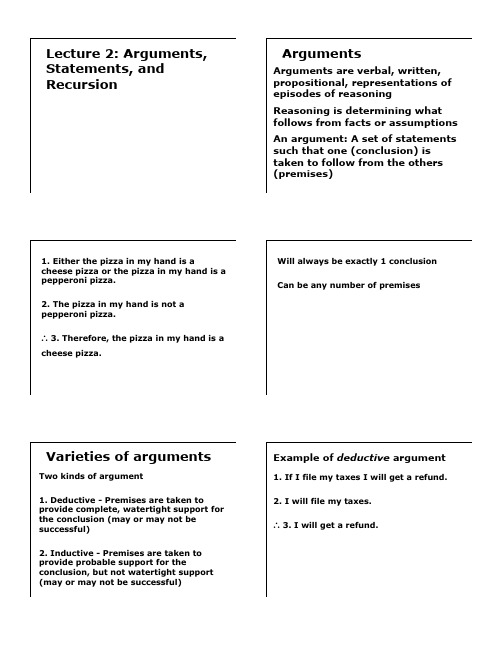
Second kind of goodness an argument can have is the truth of its premises If a deductive argument (i) is valid, and (ii) has all true premises, then it is sound. If an inductive argument (i) is strong, and (ii) has all true premises, then it is cogent.
Difference between deductive and inductive arguments is not a matter of how good the arguments are. There are good and bad inductive arguments, and good and bad deductive arguments.
Will always be exactly 1 conclusion Can be any number of premises
Varieties of arguments
Two kinds of argument 1. Deductive - Premises are taken to provide complete, watertight support for the conclusion (may or may not be successful) 2. Inductive - Premises are taken to provide probable support for the conclusion, but not watertight support (may or may not be successful)
新探索研究生英语(提高级)视听说教程U4混合式教学指导手册

Unit 4 ChangePart 1 Overview of the unitUpon completion of this unit, the T is expected to enable Ss to:Knowledge •know about how people react to change in life•learn about the concepts related to change and the past•understand the relationship between change and permanenceSkills Listening skill•follow the way a discussion develops•listen to annotate presentation slidesCritical thinking skill•evaluate deductive argumentsSpeaking skill•give group presentations•give a group presentation about proposed solutions for dealing with change Unit taskPeriods 1 & 2Check Ss’ online study (Warming up, Academic listening) Introduce the topic; deal with the video in Warming upbased on Ss’ online performance 20 min Go through Academic listening 1 based on Ss’ online performance 30 min Go through Academic listening 2 based on Ss’ online performance 30 min Deal with Getting the skill in Critical thinking20 min Ask Ss to do the oral practice of Academic listeningAsk Ss to preview A cross-cultural view and Academic communicationPeriods 3 & 4 Check Ss’ online study (A cross-cultural view, Academic communication)Deal with A cross-cultural view30 min Introduce the objectives of Academic communication;analyze the speaking model 15 min Go through the speaking skill based on Ss’ online performance 5 min Lead a thorough discussion and help Ss finish themini-project in Skill enhancement20 min Guide Ss to finish the speaking task step by step 30 min Ask Ss to upload the recordings of their presentations and complete self-evaluationHow people react to changeDenial, anger, bargaining, depression, acceptance. People usually go through these five emotions, or “stages,” when faced with a major shock in life. This “stage theory” was introduced by psychiatrist Elisabeth Kübler-Ross in her best-selling book On Death and Dying. It explains the psychological transition that occurs when we are facing death, whether that of someone we love or our own. Now it is also applied to the internal emotional journey we experience when dealing with any momentous change, disappointment or loss, or with a significant transition in life.Part 2 A detailed teaching guideLet’s take a closer look at the five stages.1. Denial. After the initial shock, people could be “in denial” by using a temporary defense mechanism to refuse to believe it. What they have been told is not true, they insist. For instance, a dying patient may believe the medical test result is wrong, the diagnosis is somehow mistaken, or there’s a cure.2. Anger. When people understand the gravity of their situation, they often become angry. Some may be angry at their life while others look for someone else to blame. They may react with strong emotions, with comments like: “Why me? It’s not fair!” or “Who did this to me?”3. Bargaining. When people are at the bargaining stage, they think of actions or promises they’re willing to do if their life could be restored to how it was before. They think about “what if-?” or “only if-?” and wish things could be done differently. They may negotiate with fate by promising to change a bad habit, do good works, or donate money to a cause if their life could go back to “normal.”4. Depression. People start facing reality and the inevitability of the change they’ve experienced at this stage. This leads them to feel sadness, fear, regret, guilt and other negative emotions. They may seem listless and indifferent, pushing others away and experiencing numbness that takes all the joy out of life.5. Acceptance. Acceptance means people start to learn to live with the change and readjust accordingly. A calm mind, stable emotions, and acknowledgement of what they can and cannot do are typical responses.The five stages are non-linear. They may happen in any order. Some people do not experience all five stages, and some find their feelings are quite different with different changes. Nevertheless, this model has been used by business leaders and therapists to understand where a person is at emotionally when confronting a crisis such as an illness, accident, financial loss, divorce or unemployment. Based on the model, many businesses create support systems for those on the path of change to help them adapt to it.Teaching suggestions1Introduce the unit topic by asking Ss questions about the major changes in their life and their emotional reactions to the changes. Then summarize the answers from Ss and bring up the topic of common reactions to change.2Ask Ss to watch the video and finish Task 2.3Check their answers for Task 2.4Use the following questions to check Ss’ understanding of the video.1)What are the five stages that people go through when faced with a major change in life?2)Why do people tend to refuse to believe the change initially?3)What are the typical responses in the acceptance stage?4)Do the five stages happen in linear time?Ss’ answers may be:1)The five stages are denial, anger, bargaining, depression and acceptance.2)Because it is a temporary defense mechanism for self-protection.3)A calm mind, stable emotions, and acknowledge of what they can and cannot do.4)No, they don’t. They may happen in any order.Reference answersTask 1 Open-ended.Task 2Stages Reactions(D) Denial A. If I made another choice, this wouldn’t have happened.(C) Anger B. This is not going away so I might as well face it.(A) Bargaining C. This is just not fair and I won’t accept it.(E) Depression D. This can’t be happening to me.(B) Acceptance E. I give up. What’s the point?Task 31. I think “depression” is the most difficult stage to get through. In this stage, people are reluctant to meet others, so they have to face the issue and get through the whole stage all by themselves.2. Open-ended.Listening 1 All change, pleaseAll change, pleaseCHRIS: We know why we’re here, right? You’ve all read the directive?HAILEY: Sure, Chris, but it doesn’t make any kind of sense. Why change something that’s working perfectly well for some system that’s too complicated to even understand? Am I alone in thinking that this is just change for change’s sake?CHRIS: No, come on Hailey. It’s not that. We have to keep ahead of the game … What works now isn’t going to work in five, ten, fifteen years, right? We have to change or die—it’s a cut-throat world out here in advertising! HAILEY: OK, you’re making it sound a little bit Hollywood … We’re just a small business, not Wall Street … But anyway, what can we actually change? Do you have any concrete ideas?CHRIS: Yes, that’s why we’re having this meeting. I’ve been doing some research, looking at the competition, asking questions … So, let’s start the ball rolling … I think there are three main areas we can improve by updating our approach to technology.RASHID: Which are?CHRIS: Well, first of all, why are we here? In this room, I mean. Couldn’t we be having this meeting from our offices, using an online tool? So, the first one is communication. And not just here, but also meeting clients online. HAILEY: Oh, come on, how’s that going to work? You know as well as I do that clients want to meet face to face, to feel that someone actually cares about them! I don’t believe they’ll want to give that up. Online meetings just don’t work.CHRIS: We can meet face to face, too. It’s just a question of deciding what needs to be done face to face and what can be done just as well online. Remember, too, that we can record online meetings, which is a lot easier than taking minutes, and we can go back over them and get closer to the customer needs. And, off the record, it’ll be a big time saver for everyone—we’ll be off home earlier …HAILEY: True, I suppose … But isn’t the technology a little bit clumsy? When I’ve been in online meetings, there are always technical problems—I can see the client, but they can’t see me, that kind of thing. It just never works like it’s supposed to!CHRIS: I do know what you’re talking about, Hailey. Yes, absolutely, we have to get the technology right—and we’ll need proper training and support.RASHID: If we’d known about this last year, we could’ve taken advantage of inviting Jackie to a few meetings before she got promoted. She is a real hotshot on technology. She knows all the software and … CHANDINI: Excuse me, Chris, if I may ask a question. Sorry, Rashid … what you’re saying is really worrying me. I don’t see how we can be giving presentations about our campaigns online! It just isn’t feasible, at all. I hear what you’re saying, but I can’t see how it will actually work in practice.CHRIS: Chandini, you’ve put your finger on the main limitation of this, but as I said, we don’t have to be rigid about using technology for every meeting. Presenting a new campaign would definitely have to be done in the old way, face to face, of course. Can I move on to the next thing?CHANDINI: Sure, go ahead, Chris. Sorry to sound negative. And sorry, Rashid, I shouldn’t have interrupted you, but I feel very strongly about this. I don’t believe in all these fashions and fads!CHRIS: No, Chandini. You don’t sound negative at all. That’s why we want to talk about it—we need your input. So, anyway, the second big change will be in the way we store documents. The plan is to do away with paper completely. We’re going to be a paperless office, as far as possible. Anyone wanna share your thoughts on this? RASHID: Yes, to be honest, I can’t believe I’m hearing this. One word comes to mind—security. We all know how easy it is to hack into a computer system. Absolute discretion is key to our business. Once a competitor gets a glimpse of a proposed advertising campaign, we may as well throw it in the trash.CHANDINI: That’s absolutely right, Rashid! How can we guarantee security if everything is going online? And I have all my files. I’ve spent the last two years improving my paper-based systems—you know how things accumulate—I wouldn’t have bothered if I’d known we were going to get rid of all the paper and leave ourselves vulnerable online.CHRIS: Look, I don’t know all the ins and outs of it, but I can tell you that we’ll be getting a very secure system. We’re going to employ a company to advise us, but I do also know that we’ll have to enforce very strict guidelines for everyone, in terms of passwords, and so on. And we’ll restrict access to the most sensitive information to a very few senior partners. As for the files, we can compile a list of things that we need to scan online and store the rest in a secure vault.HAILEY: OK, maybe you’re right … but I have my doubts. We read about security breaches at the highest government level … So, how are we going to protect ourselves? It will be impossible … well, anyway … So Chris, what’s the third thing? You said there were three.CHRIS: Ah, yes. This might be the most … let’s say, controversial of the new measures … Alex, you know, Alex, the new head of infrastructure, has decided that we’re going to move to tablets, instead of laptops … She thinks that they’ll present a more modern image to our clients …CHANDINI: I’m sorry. I’m completely lost for words. How can we do our work on a tablet? They’re good for simple tasks and some fun—I know, my children use one at home—but they simply aren’t designed for sophisticated creative work!CHRIS: Don’t worry, Chandini, you’ll keep your desktop computer to do all your work on. It’s just for when we meet clients, which as I said, we’ll continue to do … Alex wants us to project a kind of “Silicon Valley” image, I guess … She thinks we come across as dated. And she also wants to change the way we dress. No more ties for the men, apparently …RASHID: Well, that’s one good thing anyway! I hate wearing a tie, especially in this weather. Back home nobody in advertising wears a tie …Words & tipsWords and expressionsdirective n. 正式指令,指示cut-throat adj.竞争激烈的;残酷竞争的start the ball rolling 开始某事,使某事发生hotshot n. 红人;高手put your finger on sth. 确切地明白,弄清,准确地指出(错误、不同或异常之处)rigid adj. (人)顽固的,不通融的;(方法、体制等)严格死板的,僵化的fad n. 一时的狂热;时尚,风尚discretion n. 谨慎,慎重ins and outs n.(复杂的局面、难题、体系等的)详情、细节vault n.(贵重财物的)保管库,保险库come across as 给人的印象是……Proper namesChris 克里斯(人名)Hailey 黑莉(人名)Hollywood 好莱坞(美国地名,常用来指美国电影业)Wall Street 华尔街(美国纽约的一条街,美国最重要的金融中心)Jackie 杰姬(人名)Rashid 拉希德(人名)Chandini 昌迪尼(人名)Alex 亚历克丝(人名)Silicon Valley 硅谷(美国计算机工业中心)Cultural notesIn the listening material, Rashid and Chandini speak with non-standard accents. English is spoken by millions of people worldwide, sometimes as a first language and often as a learned second or third language. Users of English in today’s world need to be prepared to deal with different accents and interact with different varieties of English. It is suggested to gain exposure to different accents through listening to and watching materials from all around the world. When you are listening to different accents, practice identifying the key features of each accent. Varieties of English can also differ in the specific vocabulary used. Researching differences and asking for clarification can help.Before you listenTask1 Match the words and expressions with their definitions.(G) 1. come across as (phr. v.) A. to get rid of something(F) 2. cut-throat (adj.) B. very strict and difficult to change(D) 3. directive (n.) C. a quick look at someone or something that does not allow youto see them clearly(A) 4. do away with (phr. v.) D. an official order or instruction(H) 5. feasible (adj.) E. weak or easily hurt physically or mentally(C) 6. glimpse (n.) F. describing situations when people compete with each otherin an unpleasant way(B) 7. rigid (adj.)G. to behave in a way that makes people believe that someone has aparticular characteristic(E) 8. vulnerable (adj.) H. able to be made, done, or achievedTask 2 Complete the sentences with the following words and expressions. Change the form if necessary. come across as cut-throat directive do away withfeasible glimpse rigid vulnerable1. The employer is rigid about enforcing the new policy.2. John comes across as / came across as a very intelligent man.3. Should a company directive be followed without question?4. What household items could you happily do away with?5. What makes companies or people vulnerable in the modern world?6. Is it feasible to expect people to change household goods so often?7. Do businesses do better in a(n) cut-throat environment, or would cooperation be more effective?8. We only had a quick glimpse of the river.Task 3 Answer the following questions.1. What can we do differently now at home, in the classroom, or in the workplace thanks to technology?2. Which of these changes have you experienced personally? Do you like these changes? Why or why not? Reference answers:1. At home: Smart home devices such as smart door locks, displays and lights allow people to use their devices by remote control and enjoy customized services.In the classroom: Students now could have online classes anywhere and anytime. Teachers could use the statistics to better understand students’ learning behavior and effects and create tailor-made plans for different students.In the workplace: Digital tools such as the cloud platform and real-time communication apps help employees have better teamwork and improve their work efficiency.2. Open-ended.Global listeningTask 1 Listen to All change, please and choose the best answer to each question you hear.1. Where does the discussion happen?A. At an international university.B. At a film school.C. At an advertising company.D. At a technology company.2. What does Chris want to change?A. The standard operating procedure.B. Their approach to technology.C. Organizational culture.D. Business scope.3. Which is NOT included in the topics?A. Network upgrades.B. Online communication.C. Storing information.D. Using tablets.4. What worries the speakers most about the paperless proposal?A. Technical problems.B. Security.C. Initial costs.D. Health concerns.5. Why does Alex want to replace laptops with tablets?A. To save money.B. To save space.C. To install more applications.D. To present a more modern image.Close listeningTask 1 Listen to All change, please again and decide whether the following sentences are true or false.1. Chris argues that though a system works now, it might not work in the future.2. Hailey agrees that clients are no longer interested in face-to-face meetings.3. Chris suggests that recording meetings may be a negative action.4. Rashid mentions a colleague who could have helped with technical problems.5. Chris explains that an outside company will be totally responsible for all levels of security.6. Hailey suggests that even top-level organizations face security issues.7. Chandini knows about working on tablets from her domestic situation.8. Rashid agrees that Chris’ final point is a good idea.Answers:1. T2. F (You know as well as I do that clients want to meet face to face, to feel that someone actually cares about them!)3. F(Remember, too, that we can record online meetings, which is a lot easier than taking minutes …)4. T5. F (We’re going to employ a company to advise us, but I do also know that we’ll have to enforce very strict guidelines for everyone, in terms of passwords, and so on.)6. T7. T8. TTask 2 Answer the following questions according to what you have heard.1. How do the speakers react to the upcoming changes? Why is change important in an organization?2. What do you think of the changes? Are they good ideas? Give your reasons.Reference answers:1. Chris actively promotes the changes, while the other speakers question the necessity and effects of the changes and they seem reluctant to accept them.Change in an organization is important because it helps to encourage innovation, allow employees to learn new skills and explore new opportunities. Change helps an organization stay competitive in the cut-throat world.2.I agree with Chris’ view on change. As he mentioned in the discussion, “we have to keep ahead of the game … what works now isn’t going to work in five, ten, fifteen years …,” change is necessary for a company to grow and stay competitive. As for the ideas, I think online meetings and the paperless office are good ones, because these tools can improve work efficiency, and they are more environmentally friendly compared with traditional business tools. But replacing laptops with tablets is not a reasonable proposal because tablets have many disadvantages regarding storage, security, and compatibility.Task 3 Work in pairs to discuss the following question.What are the challenges of working with and without technology?Reference answers: 1) With technology:Lack of technical training: It may take a lot of time and effort to adapt to new techniques or facilities.Concerns about cybersecurity: Businesses need to protect sensitive intellectual property data, financial documents, and customer information.Concerns about stability: The technology may fail to work when people need it most. For example, poor internet connection, crashed websites, or invalid service may affect and even harm the business. 2) Without technology:Too much paperwork, lower work efficiency, and poorer communication are some of the major challenges.Academic listening skillMini-lecture Watch the mini-lecture and learn about the skill of followingthe way a discussion develops.Task 1 Listen to All change, please again and identify what each person does in each stage. IntroductionChris starts the discussion.Hailey 1) challenges / supports the changes. Chris 2) questions / justifies the changes. Topic 1Chris introduces the topic of online communication.Chris 3) outlines / questions the advantages of online meetings. Hailey 4) questions / agrees with the effectiveness of technology. Rashid 5) makes / asks for a suggestion.Chandini expresses 6) satisfaction with / concern about the changes. Topic 2Chris introduces the topic of storing information. Rashid 7) identifies / stops a threat.Chris 8) challenges / reassures the group. Topic 3Chris introduces the topic of tablets.Chandini 9) argues against / supports the topic.Chris 10) disagrees with / explains the reasons for the decision.Teaching suggestionsClose listening1Ask Ss to read the questions in Task 2. Then play the recording. Ask Ss to take notes while listening. 2 Ask Ss to work in pairs. Ss take turns to answer questions.3After the discussion, the T invites 1 or 2 Ss to share their answers with the whole class. The T makescomments on the Ss’ answers.You can watch the video on Ucampus.4Ask Ss to read the question in Task 3. Ss think individually for 1 minute, and then jot down several points of the challenges of working with technology and without technology.5Ss work in groups to share and compare their ideas with their group members.6The T invites 1 or 2 Ss to share their answers with the whole class. Finally, the T makes comments on the Ss’ answers.Extension activityDuring the pandemic, taking online courses has become “new normality” for many college students. The T can extend the topic by asking Ss how they feel about this change and encourage Ss to summarize the benefits and challenges of online learning.Academic listening skill1Log on Ucampus and present the task. Ask Ss to go through the structure of the group discussion. Then play the audio to check their answers.2Ask Ss to identify signpost language that shows each speaker’s role and attitude in the group discussion.Oral practiceTask 1 The following sentences will help you talk about changes in the workplace. Translate the Chinese in brackets into English using the words and expressions you’ve just learned, and then record each sentence.1. We have to change or die—it’s a cut-throat (竞争激烈的) world out here in advertising!2. I don’t see how we can be giving presentations about our campaigns online! It just isn’t feasible (可实行的),at all. I hear what you’re saying, but I can’t see how it will actually work in practice.3. You’ve put your finger on the main limitation of this, but as I said, we don’t have to be rigid (死板的) about using technology for every meeting.4. Once a competitor gets a glimpse (一瞥) of a proposed advertising campaign, we may as well throw it in the trash.5. Alex wants us to project a kind of “Silicon Valley” image, I guess … she thinks we come across as (给人的印象是……) dated.Task 2 You will hear three clips of the conversation. Each clip will be played only ONCE. After you hear a tone, please repeat the exact words the second speaker has said. You may take some notes while you listen.1.HAILEY: Why change something that’s working perfectly well for some system that’s too complicated to even understand? Am I alone in thinking that this is just change for change’s sake?CHRIS: No, come on Hailey. It’s not that. We have to keep ahead of the game … What works now isn’t going to work in five, ten, fifteen years, right?2.HAILEY: When I’ve been in online meetings, there are always technical problems—I can see the client, but they can’t see me, that kind of thing. It just never works like it’s supposed to!CHRIS: I do know what you’re talking about, Hailey. Yes, absolutely, we have to get the technology right—and we’ll need proper training and support.3.CHANDINI: Sorry to sound negative. And sorry, Rashid, I shouldn’t have interrupted you, but I feel very strongly about this. I don’t believe in all these fashions and fads!CHRIS: No, Chandini. You don’t sound negative at all. That’s why we want to talk about it—we need your input. Listening 2 Perspectives on the pastPerspectives on the pastPROFESSOR SIMPSON: OK, so I’m going to start this session on nostalgia with a brief introduction to the prevailing theories within neuroscience—that is, what happens in the brain when a person is feeling nostalgic. The practical aspects of this will be picked up later by Dr. Hossam and Stephen Johnson in their presentations. Dr. Hossam will address the sunk cost fallacy, a fascinating exploration of reactions in the present to decisions made in the past. Stephen will finish by examining the legacy issues faced by many companies nowadays, particularly in the area of technology.Now, from a theoretical perspective, we need to remember that nostalgia is a universal experience. Studies show it starts from an early age, around eight, and, regardless of culture, research shows that people feel nostalgic for aspects of their personal histories. What interests me is what changes are observable in the brain when a subject experiences nostalgia—what is the actual mechanism of nostalgia, if you like—and what triggers those changes. Looking at these two aspects will enable us to consider how nostalgia relates to other psychological phenomena. And then we can use this understanding in the field of behavioral sciences, which Dr. Hossam will explain more about, and economics—Stephen Johnson’s area.PROFESSOR SIMPSON: So, starting with the triggers, the most obvious stimulators of nostalgia are meeting old friends, hearing music, especially music we listened to between the ages of 12 and 22, and childhood smells, food, and so on—the French writer Proust springs to mind, assuming you are familiar with his novels. But, surprisingly I think, these are not actually the most common triggers. According to a series of studies published in 2006 in the Journal of Personality and Social Psychology, the most common appears to be bad moods. Now, these moods may sometimes be a result of loneliness, which seems a natural cause-effect, but actually any bad mood appears to trigger nostalgia. And so, by the way, does being cold.So there are some fundamentals from a neuroscientific perspective. There are many practical applications of this science of nostalgia, which Dr. Hossam and Stephen will tell you more about now. Dr. Hossam …DR. HOSSAM: Thank you. Now, as Professor Simpson has noted, my area is behavioral science. Today, I’m focusing on what we call the “sunk cost fallacy.” As you may know, this is the mistake we are prone to making when we take into account prior costs when making a decision on whether or not to continue a course of action—whether to “throw good money after bad” as the old proverb has it …This sunk cost fallacy does seem to be an inherited instinct, similar to nostalgia, as outlined by Professor Simpson,which guides us to poor choices in the present. People have a tendency to continue with a plan of action just because they have invested in it—time and / or money—not because it is a good strategy now. But this does lead us to question why we have developed this behavior … Perhaps “not giving up” has some hidden benefits? When we make the initial decision, we have good reasons for making it, provided that we are trying to act rationally, of course. However, once time has gone by, we have a strong tendency to forget our initial reasons. We then find ourselves in a difficult position in the present, when we have put in time and money, and not yet reached the desired outcome, do we continue with our actions, though they require more effort, time, money, or whatever … or do we cut our losses and refuse to invest any further?Now the fallacy theory is that usually we follow that instinct and keep going, in order to get something back from our investment. This can mean we end up spending far more than we would ever consider sensible, on an outcome that simply isn’t worth it. Most business advisors say this is a mistake. However, there is also an argument that the feeling that prevents us from giving up and walking away is a memory of just how important the initial decision was. The fact that the feeling remains means that we need to at least seriously try to uncover the original reasons for making the choice, and consider these before deciding to walk away from the present problem.STEPHEN JOHNSON: OK, thank you, Professor Simpson and, uh … Dr. Hossam. So, I’m here to talk about a very specific business problem relating to the past and nostalgia. On the surface, it may not seem to have much to do with what our previous speakers were describing, but I hope you’ll see the connections shortly. The problem I’m talking about concerns “legacy systems.” These are defined as technological systems which were good in their day, but which are now no longer good enough for today’s business world.So what do you do when your computer system is too old to do the job properly? Easy, you say—just change it, upgrade it. Well, I’ve got bad news for you: It’s not that easy, unfortunately. For a complex company such as a major bank, changing the computer system is a major strategic decision. I’m not talking about a change, but a complete transformation of every system, every process, every role. There is the cost, the security implications, and the data transfer—for a big bank with millions of customers worldwide, it’s a nightmare. So many things can go wrong in the changeover, but … Well, without change the company is locked into an outdated system, a legacy system, that holds them back, prevents innovation and—and this is at the root of the problem—it leaves them vulnerable to competition by smaller, more flexible banks with up-to-date systems.Part of the problem is an unwillingness to change. After all, the system worked before, the bank was profitable and, as we said, has millions of supposedly satisfied customers. Why change? And, of course, everyone has adapted their own skills to match how it works—or doesn’t work … Now, the connection to Professor Simpson’s area should be becoming evident … As she has already said, nostalgia is a neurological phenomenon, rooted in our evolutionary past … so it’s not easy to override except with a real effort … Instincts die hard! To effect change, you have to focus on the outcome and give up worrying about the huge amount of prior work and cost. And as already highlighted by Dr. Hossam, the sunk cost fallacy is a factor in any decision where work and money have already been expended.Words & tipsWords and expressionsneuroscience n. (研究大脑的)神经科学stimulator n. 刺激物spring to (sb’s) mind (某人)马上想到prone adj. 易遭……的;很有……可能的;有……倾向的changeover n. (活动、体制或工作方法的)改变,转变,变更。
外语教学中的思辨能力培养
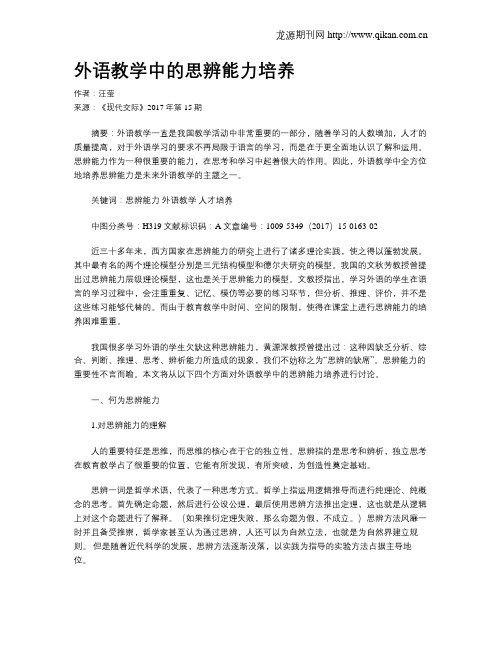
外语教学中的思辨能力培养作者:汪莹来源:《现代交际》2017年第15期摘要:外语教学一直是我国教学活动中非常重要的一部分,随着学习的人数增加,人才的质量提高,对于外语学习的要求不再局限于语言的学习,而是在于更全面地认识了解和运用。
思辨能力作为一种很重要的能力,在思考和学习中起着很大的作用。
因此,外语教学中全方位地培养思辨能力是未来外语教学的主题之一。
关键词:思辨能力外语教学人才培养中图分类号:H319文献标识码:A文章编号:1009-5349(2017)15-0163-02近三十多年来,西方国家在思辨能力的研究上进行了诸多理论实践,使之得以蓬勃发展。
其中最有名的两个理论模型分别是三元结构模型和德尔夫研究的模型。
我国的文秋芳教授曾提出过思辨能力层级理论模型,这也是关于思辨能力的模型。
文教授指出,学习外语的学生在语言的学习过程中,会注重重复、记忆、模仿等必要的练习环节,但分析、推理、评价,并不是这些练习能够代替的。
而由于教育教学中时间、空间的限制,使得在课堂上进行思辨能力的培养困难重重。
我国很多学习外语的学生欠缺这种思辨能力,黄源深教授曾提出过:这种因缺乏分析、综合、判断、推理、思考、辨析能力所造成的现象,我们不妨称之为“思辨的缺席”。
思辨能力的重要性不言而喻。
本文将从以下四个方面对外语教学中的思辨能力培养进行讨论。
一、何为思辨能力1.对思辨能力的理解人的重要特征是思维,而思维的核心在于它的独立性。
思辨指的是思考和辨析,独立思考在教育教学占了很重要的位置,它能有所发现,有所突破,为创造性奠定基础。
思辨一词是哲学术语,代表了一种思考方式。
哲学上指运用逻辑推导而进行纯理论、纯概念的思考。
首先确定命题,然后进行公设公理,最后使用思辨方法推出定理,这也就是从逻辑上对这个命题进行了解释。
(如果推衍定理失败,那么命题为假,不成立。
)思辨方法风靡一时并且备受推崇,哲学家甚至认为通过思辨,人还可以为自然立法,也就是为自然界建立规则。
论英语专业教学中思辨能力的培养
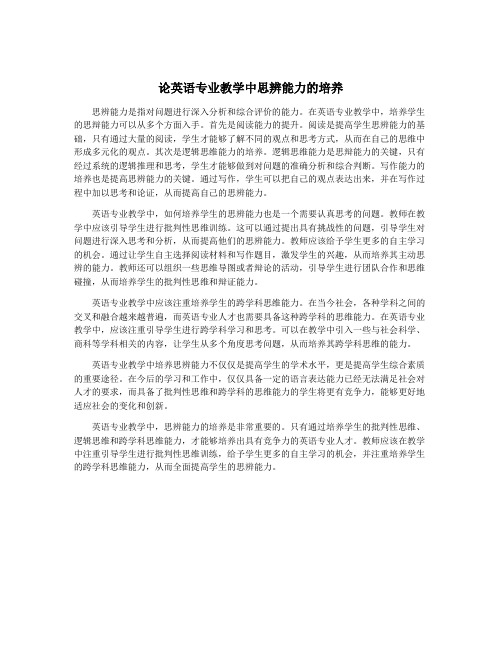
论英语专业教学中思辨能力的培养思辨能力是指对问题进行深入分析和综合评价的能力。
在英语专业教学中,培养学生的思辩能力可以从多个方面入手。
首先是阅读能力的提升。
阅读是提高学生思辨能力的基础,只有通过大量的阅读,学生才能够了解不同的观点和思考方式,从而在自己的思维中形成多元化的观点。
其次是逻辑思维能力的培养。
逻辑思维能力是思辩能力的关键,只有经过系统的逻辑推理和思考,学生才能够做到对问题的准确分析和综合判断。
写作能力的培养也是提高思辨能力的关键。
通过写作,学生可以把自己的观点表达出来,并在写作过程中加以思考和论证,从而提高自己的思辨能力。
英语专业教学中,如何培养学生的思辨能力也是一个需要认真思考的问题。
教师在教学中应该引导学生进行批判性思维训练。
这可以通过提出具有挑战性的问题,引导学生对问题进行深入思考和分析,从而提高他们的思辨能力。
教师应该给予学生更多的自主学习的机会。
通过让学生自主选择阅读材料和写作题目,激发学生的兴趣,从而培养其主动思辨的能力。
教师还可以组织一些思维导图或者辩论的活动,引导学生进行团队合作和思维碰撞,从而培养学生的批判性思维和辩证能力。
英语专业教学中应该注重培养学生的跨学科思维能力。
在当今社会,各种学科之间的交叉和融合越来越普遍,而英语专业人才也需要具备这种跨学科的思维能力。
在英语专业教学中,应该注重引导学生进行跨学科学习和思考。
可以在教学中引入一些与社会科学、商科等学科相关的内容,让学生从多个角度思考问题,从而培养其跨学科思维的能力。
英语专业教学中培养思辨能力不仅仅是提高学生的学术水平,更是提高学生综合素质的重要途径。
在今后的学习和工作中,仅仅具备一定的语言表达能力已经无法满足社会对人才的要求,而具备了批判性思维和跨学科的思维能力的学生将更有竞争力,能够更好地适应社会的变化和创新。
英语专业教学中,思辨能力的培养是非常重要的。
只有通过培养学生的批判性思维、逻辑思维和跨学科思维能力,才能够培养出具有竞争力的英语专业人才。
批判性思维谬误的21种类型
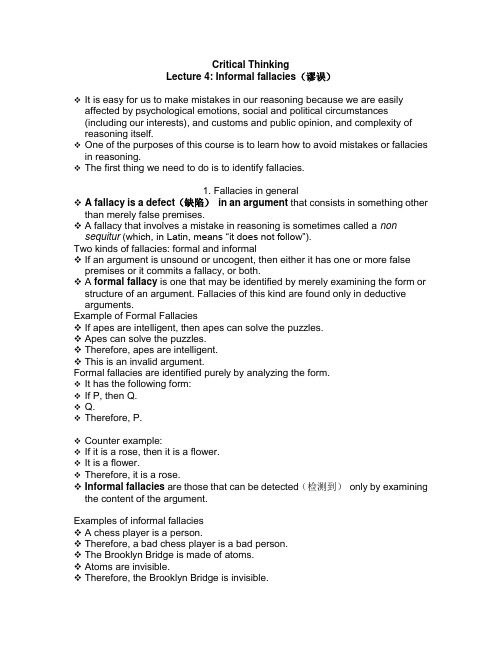
Critical ThinkingLecture 4: Informal fallacies(谬误)It is easy for us to make mistakes in our reasoning because we are easily affected by psychological emotions, social and political circumstances(including our interests), and customs and public opinion, and complexity of reasoning itself.One of the purposes of this course is to learn how to avoid mistakes or fallacies in reasoning.The first thing we need to do is to identify fallacies.1. Fallacies in generalA fallacy is a defect(缺陷)in an argument that consists in something otherthan merely false premises.A fallacy that involves a mistake in reasoning is sometimes called a nonsequitur (which, in Latin, means “it does not follow”).Two kinds of fallacies: formal and informalIf an argument is unsound or uncogent, then either it has one or more false premises or it commits a fallacy, or both.A formal fallacy is one that may be identified by merely examining the form orstructure of an argument. Fallacies of this kind are found only in deductive arguments.Example of Formal FallaciesIf apes are intelligent, then apes can solve the puzzles.Apes can solve the puzzles.Therefore, apes are intelligent.This is an invalid argument.Formal fallacies are identified purely by analyzing the form.It has the following form:If P, then Q.Q.Therefore, P.Counter example:If it is a rose, then it is a flower.It is a flower.Therefore, it is a rose.Informal fallacies are those that can be detected(检测到)only by examining the content of the argument.Examples of informal fallaciesA chess player is a person.Therefore, a bad chess player is a bad person.The Brooklyn Bridge is made of atoms.Atoms are invisible.Therefore, the Brooklyn Bridge is invisible.Fallacies of Relevance(意义,关联)The common feature to all the fallacies of relevance is that the premises are logically irrelevant to the conclusion, though they might be psychologically relevant.1. Appeal to ForceThe arguer tries to get his conclusion accepted by a person or persons by threatening that person or those persons.A girl to her boyfriend: “You should buy me a diamond necklace, otherwise I willend our relationship.”Secretary to boss: I deserve a raise in salary for the coming year. After all, you know how friendly I am with your wife, and I’m sure you wouldn’t want her to find out what’s been going on between you and that sexpot client of yours.构成,提出2. Appeal to PityInstead of providing the relevant evidence or reason, the arguer tries to evoke sympathy from the audience or the reader to get his conclusion accepted.Taxpayer to judge: Your Honor, I admit that I declared thirteen children as dependents on my tax return, even though I have only two. But if you find me guilty of tax evasion, my reputation will be ruined. I’ll probably lose my job, my poor wife will not be able to have the operation that she desperately needs, and my kids will starve. Surely I am not guilty.3. The Appeal to the People (Emotion)The arguer tries to get the conclusion accepted by playing on the listeners’ or readers’ desire to be loved, esteemed, admired, valued, or accepted by others or included in a group of people.Play on/upon 利用There are direct and indirect appeal to the people.Let us concentrate on indirect appeal.The bandwagon argument风靡的活动,时尚If you don’t do such and such, so and so, you will be left behind or out of the group.Example:Of course you want to buy Crest toothpaste, because 90 percent of Americans brush with Crest.The appeal to vanity 虚荣If you do such and such, so and so, you will be admired, pursued or imitated. Example:The Few, the Proud, the Marine.The appeal to the snobbery势利态度Similar to the appeal to vanity.A Rolls-Royce [劳斯莱斯] is not for everyone. If you qualify as one of the selectfew, this distinguished classic may be seen and driven at British Motor Cars, Ltd. (By appointment only, please.)Mother to child: You want to grow up and be just like Wonder Woman, don’t you? Then eat your liver and carrots.4. Argument Against the Person (Argumentum Ad Hominem)The arguer commits this fallacy if in his argument, he directs his attention to another arguer rather than the second arguer’s argument or position.There are three kinds of such fallacy: circumstantial, abusive and tu quoqueAd hominem-abusiveThe arguer verbally abuses or attacks another arguer. (offensively or verbal abuse)Poet Allen Ginsberg has argued in favor of abolishing censorship of pornographic literature. But his arguments are nothing but trash. Ginsberg, you know, is a marijuana-smoking homosexual and a thoroughgoing advocate of the drug culture.Ad hominem-circumstantialThe arguer discredit the opponent’s argum ent by alluding to certain circumstances about the opponent.President George W. Bush argues that we should open up the Arctic National Wildlife Refuge for oil drilling. But Bush just wants to reward his rich cronies in the oil industry who got him elect ed. Thus, we can hardly take Bush’s argument seriously.Tu quoque (you too)Child to parent: Your argument that I should stop stealing candy from the corner store is no good. You told me yourself just a week ago that you, too, stole candy when you were a kid.The judge has ruled that we are not paying our employees well enough. How can this be right when the judge’s own secretary doesn’t get paid well either?5. AccidentOne commits Accident if one misapplies (incorrectly applies) a general principle to a specific case.Dogs have four legs. Fido just had one of his legs amputated. So, Fido is not a dog any more.6. Straw ManThis fallacy is committed when an arguer distorts歪曲an opponent’s对手,竞争者argument for the purpose of more easily attacking it.Mr. Goldberg has argued against prayer in the public schools. Obviously Mr.Goldberg advocates atheism. But atheism is what they used to have inRussia. Atheism leads to the suppression of all religions and the replacementof God by an omnipotent state. Is that what we want for this country? I hardly think so. Clearly, Mr. Goldberg’s argument is nonsense.7. Missing the point (Irrelevant 不相关的Conclusion)The premises are supposed to lead to one conclusion but a totally different conclusion is drawn.Crimes of theft and robbery have been increasing at an alarming rate lately.The conclusion is obvious: we must reinstate the death penalty immediately. Certainly Miss Malone will be a capable and efficient manager. She has a great figure, a gorgeous face, and tremendous poise, and she dresses veryfashionably.8. Red HerringIt is committed when the arguer diverts the attention of the reader or listener by changing the subject to a different but sometimes subtly related one.The arguer tries to draw the audience or readers off right track and then draw a conclusion on a different issue.).There is a good deal of talk these days about the need to eliminate pesticides from our fruits and vegetables. But many of these foods are essential to our health. Carrots are an excellent source of vitamin A, broccoli is rich in iron, and oranges and grapefruits have lots of vitamin C.We’ve all heard the argument that too much television is the reason our students can’t read and write. Yet, many of today’s TV shows are excellent.“Seinfeld” explores important issues facing single people, “E.R.” pres entsmedical professionals in life-and-death situations, and “60 minutes” exposes a great variety of scams and illegal practices. Today’s TV is just great!偏离轨道Fallacies of Weak InductionPremises are relevant to the conclusion but not strong enough to draw the conclusion.9. Appeal to Unqualified AuthorityAn argument commits such a fallacy if and only if the arguer appeals to the inappropriate authority that is not the expert in the subject at hand to prove the conclusion instead of relevant evidence or appropriate authority.Pianist Ray Charles says that Sinclair paints are groovy. We can only conclude that Sinclair paints are very groovy indeed.Appropriate正确的恰当的authority must meet at least two conditions:(1) The expert on the subject.(2) There is agreement among experts in that area.“Why should I be moral?” must be one of the most important issues in ethics, because professor Stephen Darwall says so, who is one of the leadingphilosophers in ethics and there are no other moral philosophers哲学家who disagree with him.In some areas such as politics, morals, and religion, there is no appropriateauthority we can appeal to. For example,Abortion (Homosexuality) is morally wrong because according to the Bible, it is wrong.10. Appeal to IgnoranceAn argument commits this fallacy if and only if when the premises state that this statement must be true because it has not been proved false or it is falsebecause it has not been proved true.Arguments are supposed to provide positive evidence. If something is incapable of being proved or disproved, we cannot use that thing to prove or disprove a conclusion.People have been trying for centuries to provide conclusive evidence for the claims of astrology, and no one has ever succeeded. Therefore, we must conclude that astrology is a lot of nonsense.Conversely,People have been trying for centuries to disprove the claims of astrology, and no one has ever succeeded. Therefore, we must conclude that astrology is true.Two exceptions(1) If qualified researchers investigate a certain phenomenon within their rangeof expertise and fail to find any evidence, then this search can constituteevidence for a conclusion.Teams of scientists attempted over a number of decades to detect the existence of the luminiferous ether, and all failed to do so. Therefore, the luminiferous ether does not exist.(2) If it is an issue of courtroom procedure:Members of the jury, you have heard the prosecution present its case against the defendant. Nothing, however, has been proved beyond a reasonable doubt. Therefore, under the law, the defendant is not guilty.No fallacy since “Nothing has been proved beyond a reasonable doubt” is what “not guilty” means in its legal sense.11. Hasty Generalization (Converse Accident)This fallacy is commited when a general conclusion is drawn from a too small sample (a few cases) or a biased sample (not representative).On our first date, George had his hands all over me, and I found it nearly impossible to keep him in his place. A week ago Tom gave me that stupid line about how, in order to prove my love, I had to spend the night with him. Men are all alike. All any of them wants is sex.12. False CauseThe connection between the premises and the conclusion depends on an imagined causal connection that does not exist.Three types of false cause: non causa pro causa (“not the cause for the cause”), “after this, therefore, because of this” and oversimplified cause.12a. non causa pro causa (“not the cause for the cause”)During the past two months, every time that the cheerleaders have worn blue ribbons in their hair, the basketball team has been defeated. Therefore, to prevent defeats in the future, the cheerleaders should get rid of blue ribbons.12b. post hoc ergo propter hoc (after this, therefore, because of this)A few minutes after Governor Harrison finished his speech on television, adevastating earthquake struck southern Alaska. For the safety of the people up there, it is imperative that Governor Harrison make no more speeches.12c. Oversimplified causeThis variety occurs when a multitude of causes is responsible for a certain effect but the arguer selects just one of these causes and represents it as if it were the sole cause.Today, all of us can look forward to a longer life span than our parents and grandparents. Obviously, we owe our thanks to the millions of dedicateddoctors who expend every effort to ensure our health.13. Slippery SlopeIt occurs when the conclusion of an argument rests upon an alleged chain reaction and there is not sufficient reason to think that the chain reaction will actually take place.It is never a good idea to permit teenagers to drive. Almost at once, they ask for the family car for a date. They have a few beers, and pretty soon they’re in the back seat having sex. The girl gets pregnant and is forced into thehorrendous decision whether to have an abortion, or to live her life as anunmarried mother.Fallacies of Presumption, Ambiguity,and Grammatical Analogy14. Begging the Question or Circular ReasoningThe fallacy is committed when the arguer creates an illusion that inadequate premises provide adequate support for the conclusion (1) by leaving out a key premise, or (2) by restating the conclusion as a premise or assuming the truth of the conclusion in the premise(s), or (3) by reasoning in a circle.The latin name for this fallacy, petitio principii, means “request for the source.”(1) Cases of leaving out a key premiseMurder is morally wrong. This being the case, it follows that abortion is morally wrong.This argument begs the question “How do you know that abortion is a form of murder?”Clearly, terminally ill patients have a right to doctor assisted suicide. After all, many of these people are unable to commit suicide by themselves.This argument begs回避the question “Just because terminally ill patients cannot commit suicide, why does it follow that they have a right to a doctor’sassistance?”(2) Cases of restating the conclusion as a premiseAnyone who preaches revolution has a vision of the future for the simple reason that if a person has no vision of the future he could not possibly preach revolution.Capital punishment is justified for the crimes of murder and kidnapping because it is quite legitimate and appropriate that someone be put to death for having committed such hateful and inhuman acts.(3) Cases for circular reasoningFord Motor Company clearly produces the finest car in the United States. We know they produce the finest cars because they have the best designengineers. This is true because they can afford to pay them more than other manufacturers. Obviously, they can afford to pay them more because they produce the finest cars in the United States.What is the difference between “Begging the question” and valid arguments? The difference depends on whether they create an illusion that inadequate premises provide adequate support for the conclusion or not.15. Complex QuestionYes or no, you have to accept my conclusion.Have you stop beating your spouse yet?Have you stopped cheating on exams?16. False DichotomyThis fallacy is committed when one of the premises is a false dichotomy or a false disjunctive statement.A dichotomy is a pair of alternatives (states, characteristics, or conditions) thatare both mutually exclusive and jointly exhaustive. X and Y are mutually exclusive if nothing can be both X and Y. X and Y are jointly exhaustive if everything must be either X or Y.Either you buy only Chinese-made products or you don’t deserve to be called a loyal Chinese. Yesterday you bought a new Toyota. It’s therefore clear that you don’t deserve to be called a lo yal Chinese.17. Suppressed EvidenceIf the argument ignores some obvious evidence against it, it commits the fallacy of Suppressed Evidence. For example,Most dogs are friendly and pose no threat to people who pet them. Therefore, it would be safe to pet the little dog that is approaching us now.18. Equivocation含糊的It is committed when the argument depends on different senses of a term. To determine whether the argument commits the fallacy, we should be able to tell it is equivocal on what term.We have a duty to do what is right. We have the right to speak out in defenseof the innocent. Therefore, we have a duty to speak out in defense of the innocent.A mouse is an animal. Therefore, a large mouse is a large animal.19. Amphiboly有歧义It is committed when the ambiguity of a statement in the argument is due to a structural or grammatical defect.One morning I shot an elephant in my pajamas. How he got into my pajamas I'll never know.John told Henry that he had made a mistake. It follows that John has at least the courage to admit his own mistakes.Difference between ambiguity and equivocationThe Great Western Cookbook recommends that we serve the oysters when thoroughly stewed. Apparently the delicate flavor is enhanced by theintoxicated condition of the diners.20. CompositionIt is committed when the conclusion of the argument depends on the erroneous transference of a characteristic from the parts of something to the whole.Hydrogen and oxygen are gases. Therefore, H2O is a gas.21. DivisionIt is committed when the conclusion of the argument depends on the erroneous transference of a characteristic from whole to parts of something.According to a recent survey, 20 % of married women have an affair with a man other their husbands. Therefore, every married woman must sleep with a man other than her husband twice every ten days.。
英语专业口语教学中思辨能力的培养课件
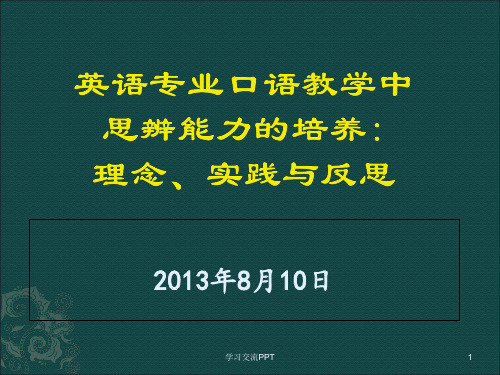
12
研究一:“英语专业口语课程设置改革问卷调 查”(段明妍、高秀峰,2010),旨在了 解学生对口语课程改革的看法;调查对象为 2007级和2008级英语、翻译、新闻三个专 业共16个班的学生。发出问卷361份,收回 有效问卷317份,回收率87.8%。
学习交流PPT
13
学习交流PPT
14
学习交流PPT
➢ 课程体系不够灵活,交际口语不能满 足入校时口语水平较高学生的需求。
学习交流PPT
27
Байду номын сангаас
学习交流PPT
28
学习交流PPT
29
对语言技能训练为主的课程体系的改革是英语 专业得以生存并进一步发展的必由之路。随 着英语始学年龄的逐步降低和各种英语培训 机构的日益繁荣,以语言技能训练为主的英 语专业只能吸引中等教育结束时英语较差的 学生。所以,我们应该尽快确定学科定位, 使外语技能的提高与学科教育和思辨能力发 展并行。
MA: Pearson Education Group).
Bloom, B.S. and Krathwohl, D. R. (1956). Taxonomy of Educational Objectives: The Classification of
Educational Goals, by a committee of college and university examiners. Handbook I: Cognitive
11
1. 《现代大学英语》口语系列教材,杨立民主编 ,2004-2006
2. 《演讲的艺术》(8th ed.),Steven Lucas, 2006
3. 《英语辩论教程》,Gary Rybold,2010 4. 《赢在辩论》,Steve Johnson, 2010
外语教学中思辨能力培养
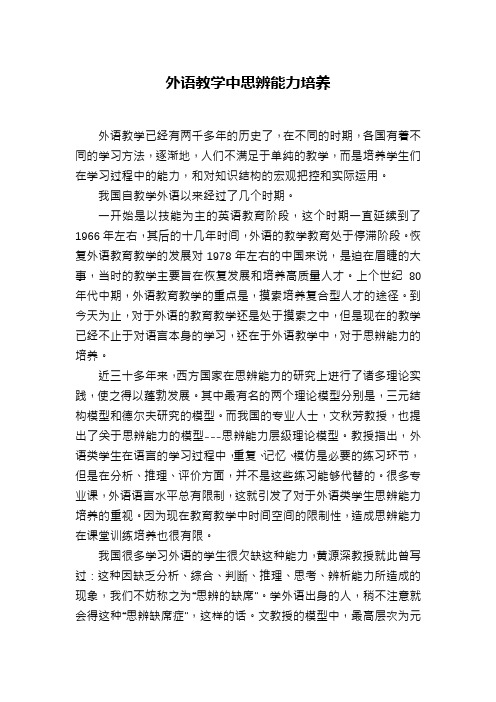
外语教学中思辨能力培养外语教学已经有两千多年的历史了,在不同的时期,各国有着不同的学习方法,逐渐地,人们不满足于单纯的教学,而是培养学生们在学习过程中的能力,和对知识结构的宏观把控和实际运用。
我国自教学外语以来经过了几个时期。
一开始是以技能为主的英语教育阶段,这个时期一直延续到了1966年左右,其后的十几年时间,外语的教学教育处于停滞阶段。
恢复外语教育教学的发展对1978年左右的中国来说,是迫在眉睫的大事,当时的教学主要旨在恢复发展和培养高质量人才。
上个世纪80年代中期,外语教育教学的重点是,摸索培养复合型人才的途径。
到今天为止,对于外语的教育教学还是处于摸索之中,但是现在的教学已经不止于对语言本身的学习,还在于外语教学中,对于思辨能力的培养。
近三十多年来,西方国家在思辨能力的研究上进行了诸多理论实践,使之得以蓬勃发展。
其中最有名的两个理论模型分别是,三元结构模型和德尔夫研究的模型。
而我国的专业人士,文秋芳教授,也提出了关于思辨能力的模型---思辨能力层级理论模型。
教授指出,外语类学生在语言的学习过程中,重复、记忆、模仿是必要的练习环节,但是在分析、推理、评价方面,并不是这些练习能够代替的。
很多专业课,外语语言水平总有限制,这就引发了对于外语类学生思辨能力培养的重视。
因为现在教育教学中时间空间的限制性,造成思辨能力在课堂训练培养也很有限。
我国很多学习外语的学生很欠缺这种能力,黄源深教授就此曾写过:这种因缺乏分析、综合、判断、推理、思考、辨析能力所造成的现象,我们不妨称之为“思辨的缺席”。
学外语出身的人,稍不注意就会得这种“思辨缺席症”,这样的话。
文教授的模型中,最高层次为元认知,或称自我调控能力,即对自己思维的计划、管理、监控和评估的技能。
该层级管理和控制着下一级的思维能力。
思维能力分为认知技能和情感特质。
在外语的学习中,学会怎么运用思辨能力使外语更加容易、深刻是很重要的。
因此,思辨能力的重要性不言而喻。
思辨能力三元结构模型与大学英语思辨能力培养
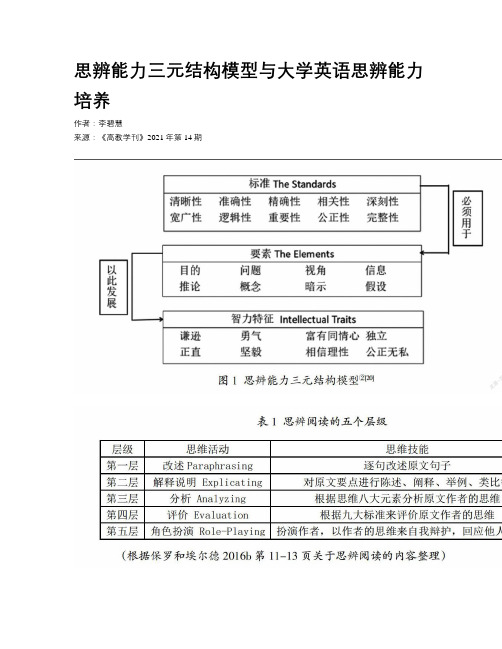
思辨能力三元结构模型与大学英语思辨能力培养作者:***来源:《高教学刊》2021年第14期摘要:在英語教学中突出思辨能力培养是20年多来国内英语教育改革的焦点之一。
思辨能力相关理论与英语教学的配适度问题一直备受关注,在大学英语课时有限的前提下,哪种思辨能力模型更加适合大学英语教学呢?理查德·保罗和琳达·埃尔德提出的由思维要素、智力特征和思辨能力标准组成的思辨能力三元结构模型及其相关理论和操作指南为大学英语教师教学和学生自学提供理论指导和实操办法,使英语水平和思辨能力同步提高。
关键词:大学英语;思辨能力;英语能力;保罗;三元结构中图分类号:G640 文献标志码:A 文章编号:2096-000X(2021)14-0007-05Abstract: The cultivation of critical thinking in English teaching has been one of the focuses of China's English teaching reform for the past two decades. How to apply critical thinking theories appropriately to English teaching has been a great concern. Taking the limited class hours of College English into consideration, this paper thinks Richard Paul and Linda Elder's critical thinking theory including elements of reasoning, intellectual traits and intellectual standards, five levels of close reading and detailed instruction can offer theoretical guidance and serve as an effective tool for college English teachers' in-class teaching and students' after-class practice and self-study, allowing students to develop English competency and critical thinking skills at the same time.Keywords: College English; critical thinking skills; English competency; Paul; the Ternary Structure经过20多年的发展,思辨能力已被许多外语教师接受。
大学英语课堂教学中学生思辨能力的培养
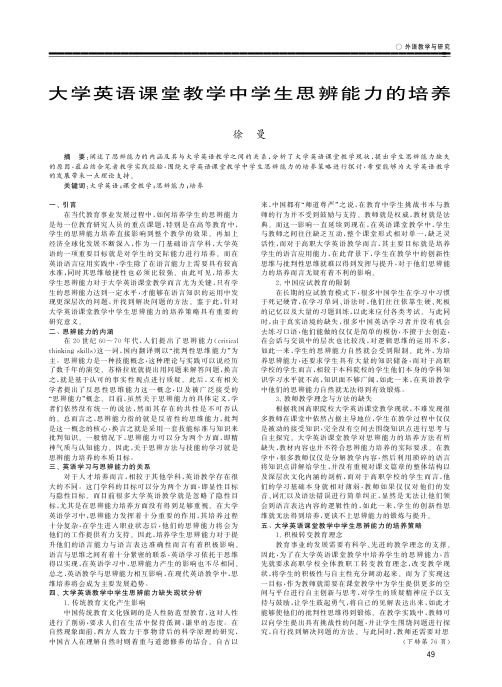
ʻ 外语教学与究
大学英语课堂教学中学生思辨能力的培养
徐㊀曼
摘㊀要: 阐述了思辨能力的内涵及其与大学英语教学之 间 的 关 系 , 分 析 了 大 学 英 语 课 堂 教 学 现 状, 提出学生思辨能力缺失 的原因 , 最后结合笔者教学实践经验 , 围绕大学英语课堂教学 中 学 生 思 辨 能 力 的 培 养 策 略 进 行 探 讨 , 希望能够为大学英语教学 的发展带来一点理论支持 . 关键词 : 大学英语 ; 课堂教学 ; 思辨能力 ; 培养 一 ㊁引言 在当代教育事业发展过程中 , 如何培 养 学 生 的 思 辨 能 力 是每一位教育研究 人 员 的 重 点 课 题 , 特 别 是 在 高 等 教 育 中, 学生的思辨能力培 养 直 接 影 响 到 整 个 教 学 的 效 果 . 再 加 上 经济全球化发展不 断 深 入 , 作 为 一 门 基 础 语 言 学 科, 大学英 语的一项重要目标 就 是 对 学 生 的 交 际 能 力 进 行 培 养 . 而 在 英语语言应用实践中 , 学生除了在语言能 力 上 需 要 具 有 较 高 水准 , 同时其思维 敏 捷 性 也 必 须 比 较 强 . 由 此 可 见 , 培养大 学生思辨能力对于大学英语课堂教学而 言 尤 为 关 键 , 只有学 生的思辨能力达到一定水平 , 才能够在语 言 知 识 的 运 用 中 发 现更深层次的问 题 , 并 找 到 解 决 问 题 的 方 法.鉴 于 此, 针对 大学英语课堂教学中 学 生 思 辨 能 力 的 培 养 策 略 具 有 重 要 的 研究意义 . 二 ㊁思辨能力的内涵 在2 人们提出了思辨能力( 0 世纪 6 0~7 0 年 代, c r i t i c a l ) , 这一 词 国 内 翻 译则以 批判性思维能力 为 t h i n k i n k i l l s gs 主 . 思辨能力是一种技能概念 , 这种理 论 与 实 践 可 以 说 经 历 了数千年的演变 . 苏格拉底就提出用 问 题 来 解 答 问 题 , 换言 之, 就是基于认可 的 事 实 性 观 点 进 行 质 疑 . 此 后 , 又有相关 学者提出了 反 思 性 思 维 能 力 这 一 概 念 , 以及被广泛接受的 思辨能力 概念 . 目 前 , 虽 然 关 于 思 辨 能 力 的 具 体 定 义, 学 者们依然没 有 统 一 的 说 法 , 然而其存在的共性是不可否认 的 . 总而言之 , 思辨 能 力 指 的 就 是 反 省 性 的 思 维 能 力 , 批判 是这一概念的核心 , 换言之就是采用一套 技 能 标 准 与 知 识 来 批判知识 . 一般情 况 下 , 思 辨 能 力 可 以 分 为 两 个 方 面, 即精 神气质与认知能力 . 因此 , 关于思辨方 法 与 技 能 的 学 习 就 是 思辨能力培养的本质目标 . 三 ㊁英语学习与思辨能力的关系 对于 人 才 培 养 而 言, 相 较 于 其 他 学 科, 英语教学存在很 大的不同 . 这门学科的目标可以分为 两 个 方 面 , 即显性目标 与隐性目标 . 而目前 很 多 大 学 英 语 教 学 就 是 忽 略 了 隐 性 目 标, 尤其是在思辨能力培养方面没有 得 到 足 够 重 视 . 在 大 学 英语学习中 , 思辨能 力 发 挥 着 十 分 重 要 的 作 用 , 其培养过程 十分复杂 , 在学生进 入 职 业 状 态 后 , 他们的思辨能力将会为 他们的工作提供有力支持 . 因此 , 培养 学 生 思 辨 能 力 对 于 提 升他们的语 言 能 力 与 语 言 表 达 准 确 性 而 言 有 着 积 极 影 响 . 语言与思维之间有着十分紧密的联系 , 英语学习依托于思维 得以实现 , 在英语学习中 , 思辨能力产 生 的 影 响 也 不 尽 相 同 . 总之 , 英语教学与思辨能力相互影响 , 在现代英语教学中, 思 维培养将会成为主要发展趋势 . 四 ㊁大学英语教学中学生思辨能力缺失现状分析 传统教育文化产生影响 1. 中国传统教育文化强调的是人性防 范 型 教 育 , 这对人性 进行了削弱 , 要求 人 们 在 生 活 中 保 持 低 调 ㊁ 谦 卑 的 态 度.在 自然现象面前 , 西方 人 致 力 于 事 物 背 后 的 科 学 原 理 的 研 究 , 中国古人在理解自 然 时 则 着 重 与 道 德 修 养 的 结 合 . 自 古 以 来, 中国都有 师道尊 严 之 说 , 在教育中学生挑战书本与教 师的行为并不受到鼓励与支持 . 教师 就 是 权 威 , 教材就是法 典 . 而这一影响一 直 延 续 到 现 在 , 在 英 语 课 堂 教 学 中, 学生 与教师之间往往缺 乏 互 动 , 整 个 课 堂 形 式 相 对 单 一, 缺乏灵 活性 , 而对于高职大 学 英 语 教 学 而 言 , 其主要目标就是培养 学生的语言应用能 力 , 在 此 背 景 下, 学生在教学中的创新性 思维与批判性思维就难以得到发挥与提 升 , 对于他们思辨能 力的培养而言无疑有着不利的影响 . 中国应试教育的限制 2. 在长期的应试教育模式下 , 很多中国 学 生 在 学 习 中 习 惯 于死记硬背 , 在学 习 单 词 ㊁ 语 法 时, 他 们 往 往 依 靠 生 硬㊁ 死板 的记忆以及大量的习题训练 , 以此来 应 付 各 类 考 试 . 与 此 同 时, 由于真实语境的 缺 失 , 很多中国英语学习者并没有机会 去练习口语 , 他们能做的仅仅是简单 的 模 仿 , 不擅于去创造, 在会话与交谈中的 层 次 也 比 较 浅 , 对 逻 辑 思 维 的 运 用 不 多, 如此一来 , 学生的 思 辨 能 力 自 然 就 会 受 到 限 制 . 此 外 , 为培 养思辨能力 , 还要求 学 生 具 有 大 量 的 知 识 储 备 , 而对于高职 学校的学生而言 , 相较于本科院校的学生 他 们 本 身 的 学 科 知 识学习水平就不高 , 知识面不够广阔 , 如此一来, 在英语教学 中他们的思辨能力自然就无法得到有效锻炼 . 教师教学理念与方法的缺失 3. 根据我国高职院校大学英语课堂教 学 现 状 , 不难发现很 多教师在课堂中依然占据主导地位 , 学生 在 教 学 过 程 中 仅 仅 是被动的接受知识 , 完全没有空间去围绕 知 识 点 进 行 思 考 与 自主探究 . 大学英语 课 堂 教 学 对 思 辨 能 力 的 培 养 方 法 有 所 缺失 , 教材内容也并不符合思辨能力 培 养 的 实 际 要 求 . 在 教 学中 , 很多教师仅仅 是 分 解 教 学 内 容 , 然后利用琐碎的语言 将知识点讲解给学生 , 并没有重视对课文 篇 章 的 整 体 结 构 以 及深层次文化内涵 的 剖 析 , 而 对 于 高 职 学 校 的 学 生 而 言, 他 们的学习基 础 本 身 就 相 对 薄 弱 , 教师如果仅仅对他们的发 音㊁ 词汇以及语法错 误 进 行 简 单 纠 正 , 显然是无法让他们领 会到语言表达内容 的 逻 辑 性 的 , 如 此 一 来, 学生的创新性思 维就无法得到培养 , 更谈不上思辨能力的锻炼与提升 . 五 ㊁大学英语课堂教学中学生思辨能力的培养策略 积极转变教育理念 1. 教育 事 业 的 发 展 需 要 有 科 学㊁ 先 进 的 教 学 理 念 的 支 撑. 因此 , 为了在大学英 语 课 堂 教 学 中 培 养 学 生 的 思 辨 能 力 , 首 先就要求高 职 学 校 全 体 教 职 工 转 变 教 育 理 念 , 改变教学现 状, 将学生的积极性与自主性充分调 动 起 来 . 而 为 了 实 现 这 一目标 , 作为教师就需要在课堂教学中为 学 生 提 供 更 多 的 空 间与平台进行自主创新与思考 , 对学生的 质 疑 精 神 应 予 以 支 持与鼓励 , 让学生鼓起勇气 , 将自己的 见 解 表 达 出 来 , 如此才 能够使他们的批判性思维得到锻炼 . 在 教 学 实 践 中 , 教师可 以向学生提出具有挑战性的问题 , 并让学 生 围 绕 问 题 进 行 探 究, 自行找到解决问题的方法.与此同时, 教师还需要对思 ( 下转第 7 6页)
关于思辨能力在高中英语教学中的培养-4页文档资料
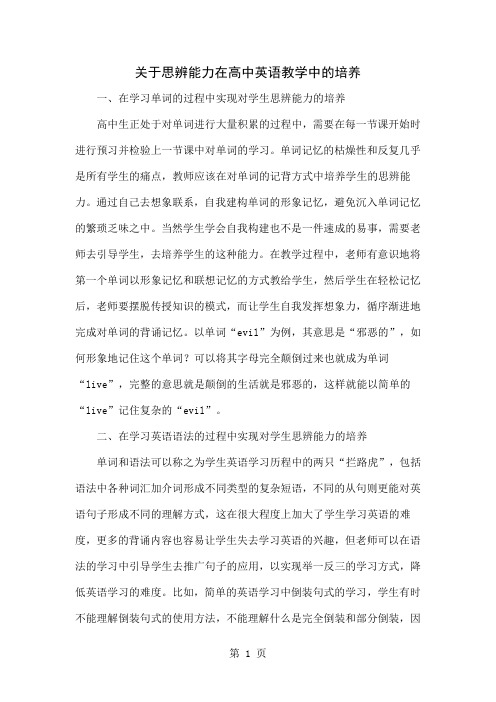
关于思辨能力在高中英语教学中的培养一、在学习单词的过程中实现对学生思辨能力的培养高中生正处于对单词进行大量积累的过程中,需要在每一节课开始时进行预习并检验上一节课中对单词的学习。
单词记忆的枯燥性和反复几乎是所有学生的痛点,教师应该在对单词的记背方式中培养学生的思辨能力。
通过自己去想象联系,自我建构单词的形象记忆,避免沉入单词记忆的繁琐乏味之中。
当然学生学会自我构建也不是一件速成的易事,需要老师去引导学生,去培养学生的这种能力。
在教学过程中,老师有意识地将第一个单词以形象记忆和联想记忆的方式教给学生,然后学生在轻松记忆后,老师要摆脱传授知识的模式,而让学生自我发挥想象力,循序渐进地完成对单词的背诵记忆。
以单词“evil”为例,其意思是“邪恶的”,如何形象地记住这个单词?可以将其字母完全颠倒过来也就成为单词“live”,完整的意思就是颠倒的生活就是邪恶的,这样就能以简单的“live”记住复杂的“evil”。
二、在学习英语语法的过程中实现对学生思辨能力的培养单词和语法可以称之为学生英语学习历程中的两只“拦路虎”,包括语法中各种词汇加介词形成不同类型的复杂短语,不同的从句则更能对英语句子形成不同的理解方式,这在很大程度上加大了学生学习英语的难度,更多的背诵内容也容易让学生失去学习英语的兴趣,但老师可以在语法的学习中引导学生去推广句子的应用,以实现举一反三的学习方式,降低英语学习的难度。
比如,简单的英语学习中倒装句式的学习,学生有时不能理解倒装句式的使用方法,不能理解什么是完全倒装和部分倒装,因而非常困惑。
简单地以一个倒装句为例:(1)There comes a dog;(2)The dog go there。
这种简单的句式很容易让学生明白这是完全倒装句,然后教师可以在简单的基础上对复杂句式进行学习,让学生能够进一步学会使用倒装句式,并且能够总结出倒装句的使用规律,进而通过反复不断的练习,将倒装句熟练地运用于口语之中。
英语阅读教学中大学生思辨能力的培养-最新教育文档
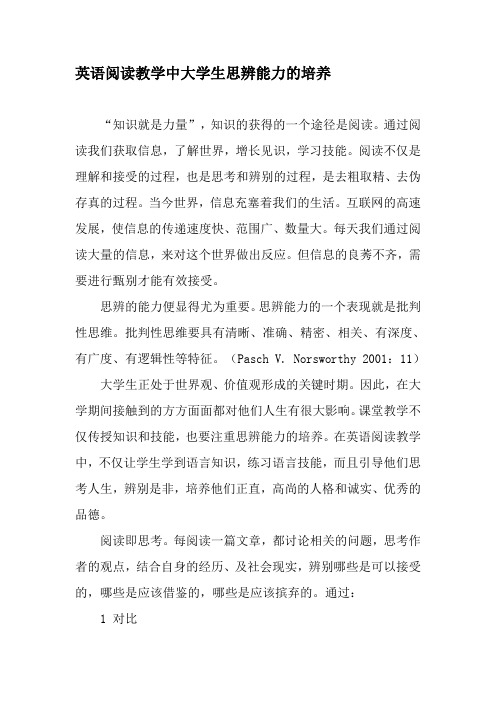
英语阅读教学中大学生思辨能力的培养“知识就是力量”,知识的获得的一个途径是阅读。
通过阅读我们获取信息,了解世界,增长见识,学习技能。
阅读不仅是理解和接受的过程,也是思考和辨别的过程,是去粗取精、去伪存真的过程。
当今世界,信息充塞着我们的生活。
互联网的高速发展,使信息的传递速度快、范围广、数量大。
每天我们通过阅读大量的信息,来对这个世界做出反应。
但信息的良莠不齐,需要进行甄别才能有效接受。
思辨的能力便显得尤为重要。
思辨能力的一个表现就是批判性思维。
批判性思维要具有清晰、准确、精密、相关、有深度、有广度、有逻辑性等特征。
(Pasch V. Norsworthy 2001:11)大学生正处于世界观、价值观形成的关键时期。
因此,在大学期间接触到的方方面面都对他们人生有很大影响。
课堂教学不仅传授知识和技能,也要注重思辨能力的培养。
在英语阅读教学中,不仅让学生学到语言知识,练习语言技能,而且引导他们思考人生,辨别是非,培养他们正直,高尚的人格和诚实、优秀的品德。
阅读即思考。
每阅读一篇文章,都讨论相关的问题,思考作者的观点,结合自身的经历、及社会现实,辨别哪些是可以接受的,哪些是应该借鉴的,哪些是应该摈弃的。
通过:1 对比对比当今社会,对比自身经历,反思现实,吸取经验,增加辨别能力。
“有比较才能有鉴别”。
学会对事物进行比较与鉴别,才能发现自己的不足与缺陷,加深对事情的理解,从而提高识别能力。
英语的阅读理解主要来自西方的文字材料,尤其是在阅读文学、故事、报道、杂文这种体裁的文章时,由于文化的不同,社会制度的不同,学生们要学会比较,去粗取精,去伪存真,吸取于自己有利的,舍弃于自己有害的,才能有利于自己的成长。
2 延展延展文中观点和主张,多点思维,多角度思考,使思考范围扩大,培养学生的发散思维。
在讨论问题的时候,发现部分学生只想到与自己相关的问题和自己关心的问题,对社会,对他人缺乏关心,缺乏思考。
这样便造成思维狭窄,心胸不开阔。
培养学生思辨能力的教案
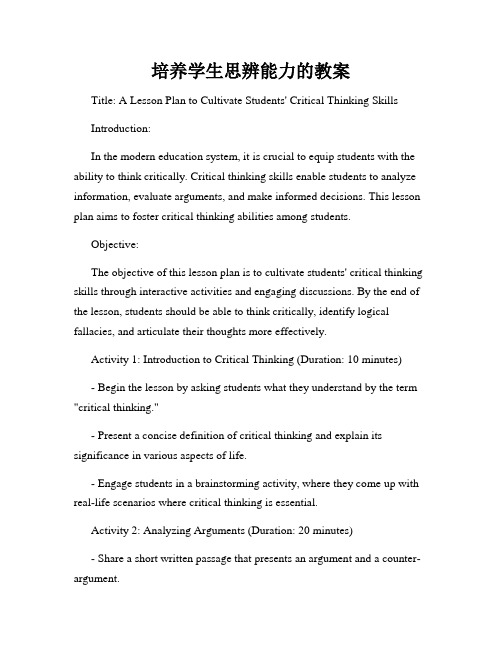
培养学生思辨能力的教案Title: A Lesson Plan to Cultivate Students' Critical Thinking SkillsIntroduction:In the modern education system, it is crucial to equip students with the ability to think critically. Critical thinking skills enable students to analyze information, evaluate arguments, and make informed decisions. This lesson plan aims to foster critical thinking abilities among students.Objective:The objective of this lesson plan is to cultivate students' critical thinking skills through interactive activities and engaging discussions. By the end of the lesson, students should be able to think critically, identify logical fallacies, and articulate their thoughts more effectively.Activity 1: Introduction to Critical Thinking (Duration: 10 minutes)- Begin the lesson by asking students what they understand by the term "critical thinking."- Present a concise definition of critical thinking and explain its significance in various aspects of life.- Engage students in a brainstorming activity, where they come up with real-life scenarios where critical thinking is essential.Activity 2: Analyzing Arguments (Duration: 20 minutes)- Share a short written passage that presents an argument and a counter-argument.- Divide students into pairs or small groups and provide them with copies of the passage.- Instruct students to identify the main claim, supporting evidence, and logical fallacies present in both the argument and counter-argument.- Encourage students to discuss and debate their findings within their groups.Activity 3: Case Study Analysis (Duration: 30 minutes)- Hand out case studies to each group, focusing on different fields such as politics, science, or ethics.- Instruct students to read the case study individually and jot down their initial thoughts and impressions.- Facilitate a group discussion where students analyze the given case studies from different perspectives.- Encourage students to question assumptions, evaluate evidence, and propose alternative solutions.Activity 4: Debating Issues (Duration: 30 minutes)- Assign pairs or small groups specific topics for debate, such as the benefits and drawbacks of technology in education or the impact of social media on society.- Instruct each group to research their assigned topic, gather relevant data, and prepare arguments.- Conduct a formal debate where students present their arguments, counter-arguments, and engage in respectful rebuttals.- Encourage students to consider different viewpoints and defend their arguments using evidence and logical reasoning.Activity 5: Reflective Writing (Duration: 20 minutes)- Ask students to individually write a reflective essay on their learning experience during the lesson.- Prompt them to describe how their critical thinking skills have developed and provide specific examples.- Encourage students to identify areas in which they still need improvement and propose strategies for further enhancing their critical thinking abilities.Conclusion:By implementing this well-structured lesson plan, teachers can effectively nurture students' critical thinking skills. Through activities that stimulate analysis, debate, and reflection, students will become more adept at evaluating information, identifying logical fallacies, and formulating well-reasoned arguments. This lesson plan equips students with a valuable life skill that will serve them in their academic journeys and future endeavors.。
大学英语阅读教学中思辨能力的培养-精品作文
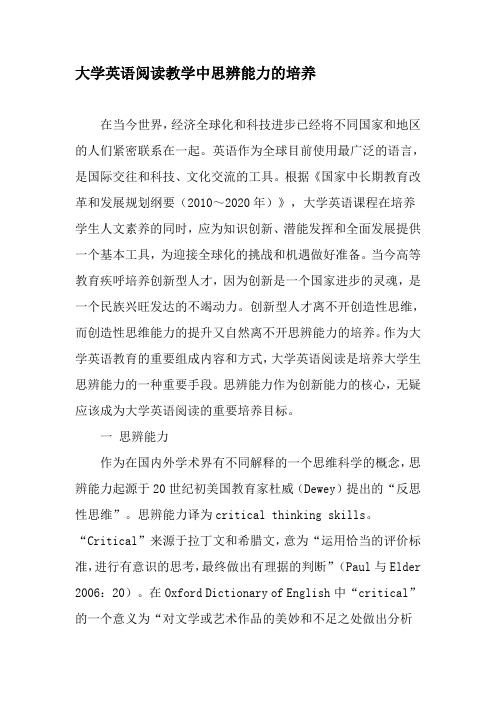
大学英语阅读教学中思辨能力的培养在当今世界,经济全球化和科技进步已经将不同国家和地区的人们紧密联系在一起。
英语作为全球目前使用最广泛的语言,是国际交往和科技、文化交流的工具。
根据《国家中长期教育改革和发展规划纲要(2010~2020年)》,大学英语课程在培养学生人文素养的同时,应为知识创新、潜能发挥和全面发展提供一个基本工具,为迎接全球化的挑战和机遇做好准备。
当今高等教育疾呼培养创新型人才,因为创新是一个国家进步的灵魂,是一个民族兴旺发达的不竭动力。
创新型人才离不开创造性思维,而创造性思维能力的提升又自然离不开思辨能力的培养。
作为大学英语教育的重要组成内容和方式,大学英语阅读是培养大学生思辨能力的一种重要手段。
思辨能力作为创新能力的核心,无疑应该成为大学英语阅读的重要培养目标。
一思辨能力作为在国内外学术界有不同解释的一个思维科学的概念,思辨能力起源于20世纪初美国教育家杜威(Dewey)提出的“反思性思维”。
思辨能力译为critical thinking skills。
“Critical”来源于拉丁文和希腊文,意为“运用恰当的评价标准,进行有意识的思考,最终做出有理据的判断”(Paul与Elder 2006:20)。
在Oxford Dictionary of English中“critical”的一个意义为“对文学或艺术作品的美妙和不足之处做出分析和评判”。
在现有的研究中,教育专家们对思辨能力给出了不同的解读。
国外学者Ermis(1989)提出,思辨能力是指“对做什么和相信什么做出合理决策的能力”。
国内学者文秋芳(2009)认为思辨能力作为思维能力的重要部分,反映了高等教育的培养目标。
总之,思辨能力就是指思考辨析的能力,它强调的是经过自己认真地分析和论证,运用恰当的评价标准进行思考,挑出自己认为重要和正确的东西,最终做出有理据的判断。
思辨能力能帮助我们对遇到的问题进行合理的分析判断,有目的地选择正确的信息,并在此基础上理性地解决问题。
深度思考培养学生的思辨能力

深度思考培养学生的思辨能力在当今社会,培养学生的思辨能力变得越来越重要。
思辨能力是指个体通过对事物进行逻辑推理、反思和判断的能力。
它不仅能促进学生的学术成长,还能培养他们的创新思维和解决问题的能力。
所以,如何在教育中培养学生的思辨能力成为了一个重要的课题。
本文将探讨深度思考培养学生思辨能力的方法与策略。
一、培养对问题的敏感性促进学生深度思考的第一步是培养对问题的敏感性。
学生应该学会质疑并针对问题进行思考。
教师可以通过提供开放性的问题,引导学生思考,并指导他们寻找问题的本质以及可能的解决方案。
例如,当教授数学问题时,可以引导学生思考如何运用数学知识解决实际问题,而不仅仅是解算题。
这样的引导能够激发学生的思考动力,提升他们的问题意识和思考能力。
二、培养逻辑思维能力逻辑思维是深度思考的重要组成部分。
学生应该学会运用逻辑思维进行分析和判断。
教师可以通过教授逻辑学、哲学等相关课程,或是提供逻辑思维训练的资源和活动来帮助学生培养逻辑思维能力。
例如,教师可以提供一组材料,让学生分析其中的逻辑关系,并论证自己的观点。
这样的训练能够锻炼学生的思考能力,并加深对问题的理解和解决方法的把握。
三、培养批判性思维能力培养学生的批判性思维能力也是培养思辨能力的重要环节。
学生需要学会对信息进行辨别和批判,从而得出合理的结论。
教师可以通过讨论、辩论等形式,引导学生从多个角度思考并评估信息的可靠性和准确性。
例如,在教授科技类课程时,可以提供一些科技新闻让学生进行分析和评价,进而培养批判性思维能力。
四、培养创新思维能力培养学生的创新思维能力也是培养思辨能力的关键之一。
创新思维是指学生能够提出新颖的观点、方法或解决方案。
教师可以通过启发性问题、开放式实验和项目等方式来激发学生的创新思维。
例如,在教授语文课程时,可以要求学生重新解读经典作品,并提出他们自己的观点和理解。
这样的练习既能够锻炼学生创新思维,又能够培养他们的思辨能力。
五、培养实践思考能力实践思考是指学生能够将所学的知识与实际情境相结合,并加以运用和探索。
- 1、下载文档前请自行甄别文档内容的完整性,平台不提供额外的编辑、内容补充、找答案等附加服务。
- 2、"仅部分预览"的文档,不可在线预览部分如存在完整性等问题,可反馈申请退款(可完整预览的文档不适用该条件!)。
- 3、如文档侵犯您的权益,请联系客服反馈,我们会尽快为您处理(人工客服工作时间:9:00-18:30)。
premises are all true.
Since Chengdu is west of Wuhan and Urumqi is west of Chengdu, Urumqi must be west of Wuhan. Witches (女巫们) float because witches are made of wood and wood floats.
true
A valid deductive argument is a truthpreserving (维护事实) argument.
In other words, in a valid deductive argument the truth of the premises is preserved (维护) in the truth of the conclusion. If a deductive argument is valid (and the premises are true), we can be 100% certain of the conclusion. If it is invalid, however, it proves nothing and is completely useless!
Argument 2
All Americans are capitalists. Roger is a capitalist.
Therefore Roger is an American.
The sun is coming out so the rain should stop soon. If Tom goes to the party, Dana will also go. Tom is at the party. Therefore Dana is at the party. Either Lu Meng is in class or she is in her dormitory. She is not in class, therefore she is in her dormitory. I once ate a 糖葫芦 and got sick. Therefore, if we want good health, we should avoid eating 糖葫芦. The dog woபைடு நூலகம்ld have barked if it had seen a robber. The dog didn’t bark so it didn’t see a robber. No one in Paris understands me, so either my French is poor or Parisians are idiots.
Premise 1 : It is Tuesday.
Premise 2 : Glenn always wears a grey waistcoat on Tuesday.
Conclusion : Glenn will be wearing a grey waistcoat today.
Premise 1 : All men are mortal.
Premise 2 : Socrates is a man.
Conclusion : Therefore Socrates is mortal.
A deductive argument guarantees its conclusion
i.e. if the premises are true, the conclusion MUST be
Know the difference between deductive and inductive arguments Be able to recognise a valid from an invalid deductive argument
Deductive arguments
&
Inductive Arguments
Premise : The sun has risen every morning during the entire history of the earth. Conclusion : The sun will rise tomorrow morning.
Argument 1
All Americans are capitalists. Roger is an American. Therefore Roger is a capitalist.
Lecture 3 Deductive Arguments
Propositions are either true or false.
Arguments are NOT true or false. Arguments are either good or bad, valid or invalid, strong or weak.
A good deductive argument has two characteristics:
(1)The
conclusion follows (必然发生) from the premises (i.e. the argument is valid/truth-preserving).
(2)The
